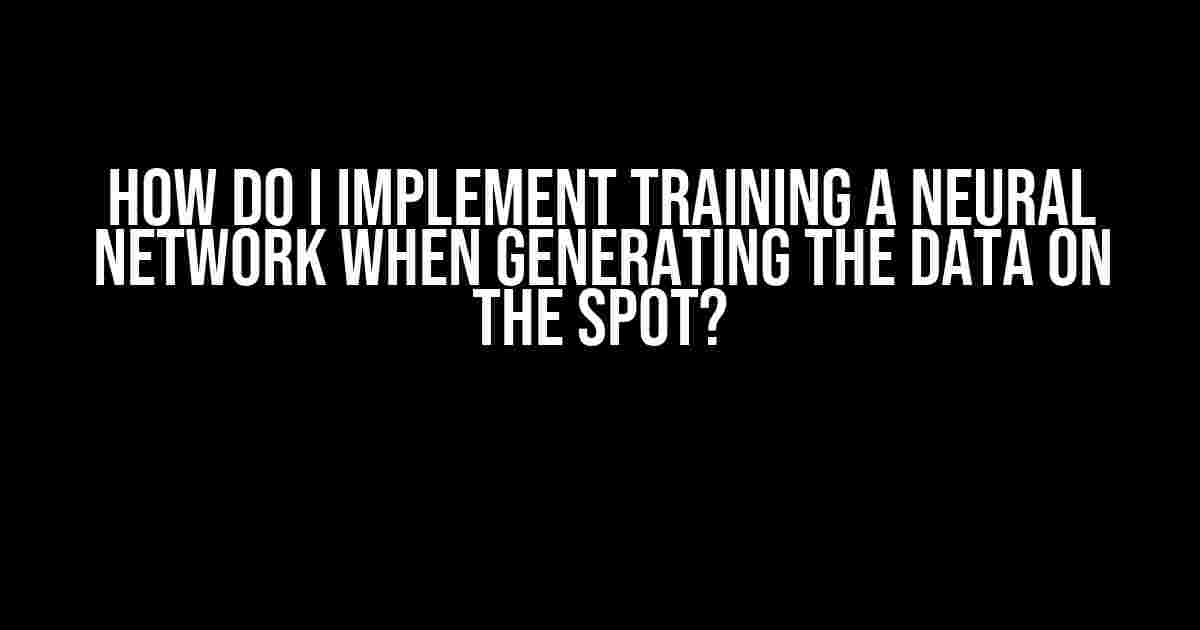Are you tired of dealing with pre-existing datasets and want to take your neural network training to the next level? Generating data on the spot can be a game-changer, but it requires a unique approach. In this article, we’ll dive into the world of dynamic data generation and explore the best practices for implementing training a neural network when generating data on the spot.
Why generate data on the spot?
There are several benefits to generating data on the spot:
- Faster development cycle: By generating data dynamically, you can iterate faster and make changes to your model without waiting for data collection or preparation.
- Increased flexibility: Dynamic data generation allows you to adapt to changing requirements or experiment with new approaches quickly.
- Improved data quality: By generating data on the spot, you can ensure that it’s relevant, up-to-date, and tailored to your specific use case.
Understanding the challenges
However, generating data on the spot also presents some unique challenges:
- Data quality and consistency: When data is generated dynamically, it can be difficult to ensure consistency and quality.
- Model stability and convergence: Training a neural network on dynamically generated data can lead to instability and convergence issues.
- Computational resources: Generating data on the spot can be computationally intensive, requiring significant resources.
Preparing your neural network for dynamic data generation
To successfully implement training a neural network when generating data on the spot, you’ll need to make some key adjustments:
1. Design a flexible architecture
A flexible architecture is crucial for handling dynamic data generation. Consider using:
- Modular neural networks with interchangeable components
- Architecture search algorithms to find the best design for your specific use case
- Hyperparameter tuning to adapt to changing data distributions
2. Implement data augmentation techniques
Data augmentation can help increase the diversity of your generated data and improve model robustness:
- Image augmentation: flipping, rotating, cropping, and color jittering
- Text augmentation: sentence shuffling, word replacement, and synonym insertion
- Time-series augmentation: windowing, resampling, and masking
3. Utilize online learning techniques
Online learning allows your neural network to adapt to new data as it’s generated:
- Incremental learning: training on small batches of data and updating the model incrementally
- Streaming data processing: processing data in real-time as it’s generated
- Adaptive learning rates: adjusting the learning rate based on the changing data distribution
Implementing dynamic data generation
Now that we’ve covered the preparation steps, let’s dive into the implementation details:
1. Choose a data generation method
There are several approaches to generating data on the spot:
- Synthetic data generation: using algorithms to generate artificial data
- Simulation-based data generation: using simulations to generate realistic data
- Hybrid approaches: combining synthetic and simulation-based methods
2. Integrate data generation with your neural network
Once you’ve chosen a data generation method, you’ll need to integrate it with your neural network:
import numpy as np
import torch
import torch.nn as nn
import torch.optim as optim
# Data generation function
def generate_data(batch_size):
# Synthetic data generation example
X = np.random.rand(batch_size, 10)
y = np.random.rand(batch_size, 1)
return X, y
# Neural network architecture
class Net(nn.Module):
def __init__(self):
super(Net, self).__init__()
self.fc1 = nn.Linear(10, 20)
self.fc2 = nn.Linear(20, 1)
def forward(self, x):
x = torch.relu(self.fc1(x))
x = self.fc2(x)
return x
# Train the neural network
net = Net()
criterion = nn.MSELoss()
optimizer = optim.Adam(net.parameters(), lr=0.001)
for epoch in range(100):
X, y = generate_data(32) # Generate data on the spot
X, y = torch.tensor(X), torch.tensor(y)
optimizer.zero_grad()
outputs = net(X)
loss = criterion(outputs, y)
loss.backward()
optimizer.step()
print(f'Epoch {epoch+1}, Loss: {loss.item()}')3. Monitor and adapt to changing data distributions
As your data generation method produces new data, your neural network may need to adapt to changing data distributions:
- Monitor data quality and consistency metrics
- Adjust the data generation method or neural network architecture as needed
- Regularly re-train or fine-tune the neural network to ensure it remains accurate
Best practices and considerations
When implementing training a neural network when generating data on the spot, keep the following best practices and considerations in mind:
| Best Practice | Consideration |
|---|---|
| Use modular neural networks | Ensure the neural network can adapt to changing data distributions |
| Implement data augmentation | Avoid over-augmentation, which can lead to decreased model performance |
| Monitor data quality and consistency | Regularly inspect data for anomalies or inconsistencies |
| Use online learning techniques | Ensure the neural network can handle concept drift and changing data distributions |
Conclusion
Training a neural network when generating data on the spot can be a powerful approach, offering flexibility, speed, and improved data quality. By understanding the challenges, preparing your neural network, and implementing dynamic data generation, you can unlock the full potential of this approach. Remember to monitor and adapt to changing data distributions, and keep the best practices and considerations in mind.
With great power comes great responsibility – so get generating and start training your neural network today!
Further reading
Want to dive deeper into the world of dynamic data generation and online learning? Check out these resources:
- SimGAN: A Simulation-based Generative Adversarial Network for Data Generation
- Online Learning and Stochastic Approximation
- Dynamic Data Generation for Neural Network Training
Happy learning, and happy generating!
Frequently Asked Question
Generating data on the spot while training a neural network can be a bit tricky, but don’t worry, we’ve got you covered!
How do I handle cases where my dataset is too large to fit in memory?
When dealing with massive datasets, it’s essential to use techniques like data chunking, batch processing, or using generators to feed your data to the neural network in chunks, thus avoiding memory overload. This approach allows you to process your data in smaller, manageable pieces, making it more efficient and scalable.
What’s the best way to shuffle my dataset while generating it on the spot?
When generating data on the fly, shuffling becomes a bit more complex. One approach is to use a buffer to store a batch of generated data, then shuffle that batch before feeding it to your neural network. Another strategy is to use a random number generator to decide the order in which you generate your data, effectively shuffling it as you go.
Can I use parallel processing to speed up data generation and training?
Parallel processing can be a game-changer when generating data on the spot. By distributing the data generation process across multiple processors or machines, you can significantly speed up the process. This allows you to take advantage of multi-core CPUs, GPUs, or even distributed computing architectures to generate your data in parallel.
How do I ensure data consistency and integrity when generating data on the spot?
To maintain data consistency and integrity, it’s crucial to implement robust data generation processes that guarantee the same output given the same inputs. This can be achieved by using deterministic algorithms, checksums, or digital signatures to verify the integrity of your generated data. Additionally, consider implementing data validation and sanitization techniques to ensure your generated data meets the required standards.
Are there any specific deep learning frameworks that support generating data on the spot?
Yes, several deep learning frameworks provide built-in support for generating data on the spot. For example, TensorFlow’s `tf.data` API and PyTorch’s `DataLoader` class allow you to create custom data generators that can produce data in real-time. Other frameworks like Keras and Hugging Face’s Transformers also provide support for data generation and augmentation.



